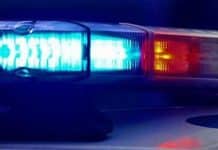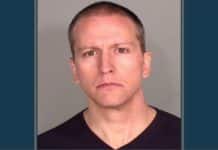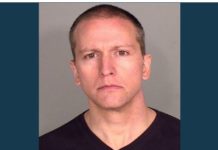
May 30 (UPI) — Protests erupted in dozens of cities across the United States overnight as activists called for justice for the death of George Floyd in Minneapolis.
Speaking during a news conference Saturday, Minneapolis Gov. Tim Walz blamed the violence on groups unrelated to the Floyd cause, including anarchists, white supremacists and drug cartel participants. He said he plans to mobilize the National Guard to keep the peace for any further weekend protests.
“Our cities of Minneapolis and St. Paul are under assault,” he said, blaming riots on “an organized attempt to destabilize society.”
Walz said he spoke with Floyd’s family, who said the violence that had overtaken the city was counterproductive to the message activists were trying to send about the 46-year-old’s death.
Floyd died Monday after Minneapolis police officer Derek Chauvin kneeled on his neck during an arrest for nearly 9 minutes. There have been daily protests since the incident — which was recorded on video — calling for the officer and three others present during the arrest to face charges.
Chauvin was charged Friday with third-degree murder, and bail was set at $500,000. All four officers, including Thomas Lane, J. Alexander Kueng and Tou Thao, were fired from the MPD.
Minneapolis
Protesters took to the streets across the country Friday night, many beginning as peaceful demonstrations that later took a more violent turn. Several buildings were torched while businesses were vandalized and looted.
In the early hours of Saturday, Walz implored protesters to disperse.
“The absolute chaos — this is not grieving, and this is not making a statement [about an injustice] that we fully acknowledge needs to be fixed — this is dangerous,” he said. “You need to go home.”
“The sheer number of rioters has made it impossible to make coherent arrests,” he added Saturday morning. “The capacity to be able to do offensive action was greatly diminished.”
“The terrifying thing is that this resembles more a military operation now as you observe ringleaders moving from place to place.”
Walz activated the National Guard earlier in the week, and 500 responded to Friday night’s protests. The Minnesota National Guard tweeted Saturday that it’s activating an additional 1,000 service members Saturday.
“This represents the largest domestic deployment in the Minnesota National Guard’s 164-year history,” the agency said.
Washington, D.C.
Protests gripped the nation’s capital, as well, with some 2,000 activists gathering outside the White House. The Secret Service temporarily put the White House on lockdown Friday evening, not allowing anyone to leave or enter the building.
Some people said President Donald Trump’s tweet calling protesters “thugs” only served to enflame tensions, WRC-TV reported.
“We are human beings that want justice for our people,” participant Anzhane Laine told the news station.
Washington, D.C., police officers arrested five people, including one woman who allegedly climbed over a barrier. Local officials said multiple Secret Service officers sustained injuries.
Officers deployed pepper spray into the crowd as they pushed against metal barriers and tried to remove them.
President Donald Trump condemned the protests outside the White House as having nothing to do with Floyd. He also praised the actions of the Secret Service.
“Big crowd, professionally organized, but nobody came close to breaching the fence. If they had, they would have been greeted with the most vicious dogs, and most ominous weapons I have ever seen,” Trump said in a series of tweets.
New York City
Police and thousands of demonstrators clashed outside the Barclays Center in Brooklyn, with protesters throwing water bottles and other objects at officers. The police shot tear gas to try to disperse the crowd, which chanted “black lives matter” and “we want justice.”
Police made between 50 to 100 arrests, a senior police official told The New York Times.
Crowds also gathered in the nearby Fort Greene neighborhood, setting a patrol van on fire and tossing fireworks.
Atlanta
Atlanta Mayor Keisha Lance Bottoms called for calm Friday night after protesters there torched a visitors center at Centennial Olympic Park and vandalized the CNN Center.
“This is not a protest,” she said. “This is not in the spirit of Martin Luther King Jr. This is chaos. A protest has purpose. When Dr. King was assassinated, we didn’t do this to our city. You are disgracing our city. You are disgracing the life of George Floyd and every other person who has been killed in this country.”
Police said they clashed with protesters, who threw knives, eggs, firecrackers and other debris. Officers fired tear gas into the crowds.
Georgia Gov. Brian Kemp said Saturday he plans to deploy the National Guard to quell the disorder.
Kentucky
Demonstrators in Louisville protested not only the death of Floyd, but also that of Breonna Taylor, a 26-year-old emergency medical technician killed while in bed in her own apartment when police conducted a raid.
Her boyfriend, Kenneth Walker, who was also shot in the March 13 raid, said police didn’t identify themselves when they forced their way into the apartment. Thinking the plainclothes officers were robbers, Walker said he discharged his gun, injuring one of the officers.
Police opened fire, killing Taylor.
Protesters in Louisville and Lexington called for an end of police violence against unarmed black people. The march in Lexington was largely peaceful, shutting down roads as they progressed through the city.
Police shot tear gas and pepper bullets in Louisville, though, to disperse crowds. Footage from the protest appeared to show a Louisville Metro Police Department officer directly targeting at a WAVE-TV reporter and cameraman with pepper bullets.
Portland, Ore.
Portland Mayor Ted Wheeler declared a state of emergency in response to protests and imposed a curfew for the weekend.
Protesters set fire to the Multnomah County Justice Center, which includes the county jail and a police precinct. People were working inside the building, but they were able to evacuate and the facility’s sprinkler system doused the flames.
“Burning buildings with people inside, stealing from small and large businesses, threatening and harassing reporters,” Wheeler said. “All in the middle of a pandemic where people have already lost everything. This isn’t calling for meaningful change in our communities, this is disgusting.”
California
Protests took place in several cities across California, with more than 400 people arrested in Los Angeles amid clashes with police. The Los Angeles Police Department said five officers were injured during the confrontations, one with a head injury and another with a broken hand.
“It’s unsafe. It’s an unlawful assembly,” LAPD Chief Michel Moore. “It’s dangerous for all the residents and others. So it’s unfortunate. It’s a dark day in our history, that we have to do this, but this is what’s going to save lives and this is going to save property.”
In San Jose, protesters briefly shut down Highway 101 during a tense standoff with police. One protester charged at and punched one officer before he was arrested.
San Jose police later opened live fire on an SUV that hit two protesters after the occupants of the vehicle got into a verbal confrontation with protesters. Demonstrators threw objects at the SUV before it went into reverse, running over one pedestrian and knocking over another.
Protests were also seen in several cities in Denver; Chicago; Des Moines, Iowa; New Orleans; Lincoln, Neb.; Boston; Detroit; Kansas City, Mo.; Las Vegas; Charlotte, N.C.; Richmond, Va.; and Seattle; and several cities in Indiana, Ohio and Texas.





